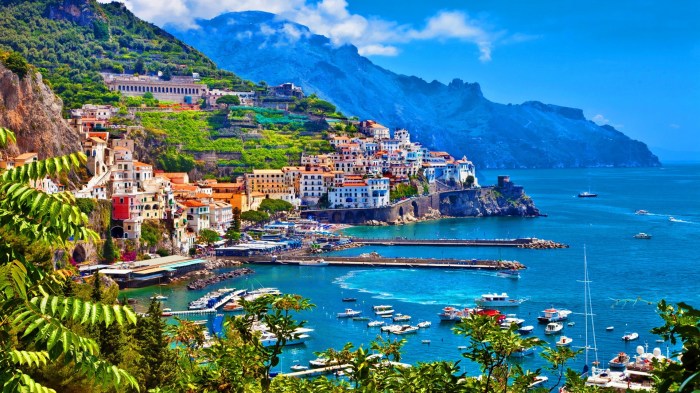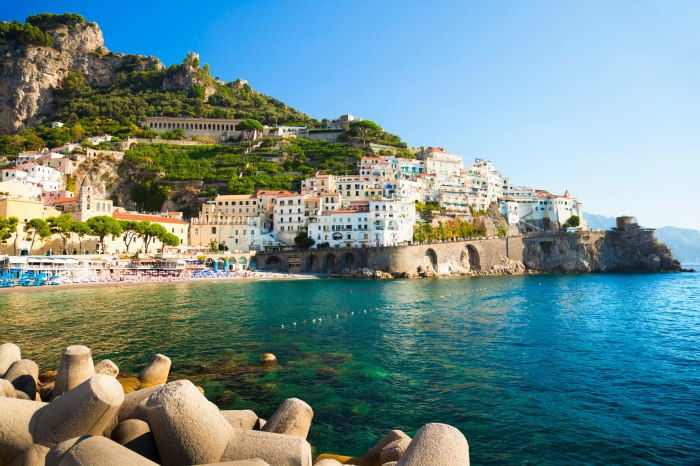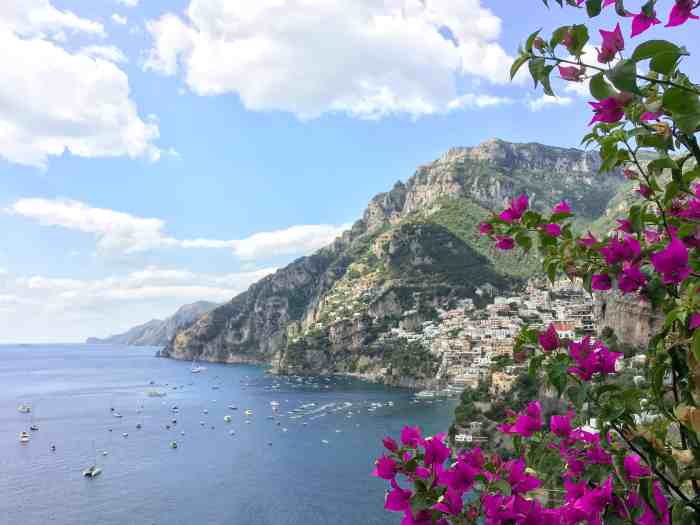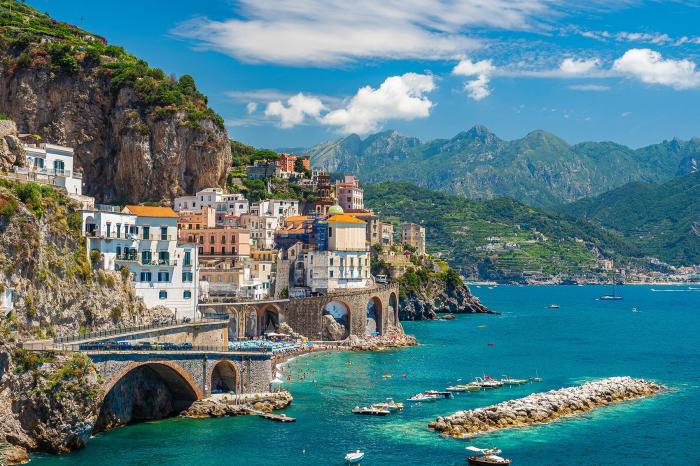Nestled along the breathtaking coastline of southern Italy, the Amalfi Coast beckons travelers with its captivating blend of natural wonders, historical treasures, and cultural charm. From its dramatic cliffs and azure waters to its picturesque towns and vibrant streets, the Amalfi Coast offers an unforgettable experience that lingers long after your visit.
Steeped in history and legend, the Amalfi Coast played a pivotal role as a maritime republic and trading hub during the Middle Ages. Its legacy is evident in the region’s architectural masterpieces, such as the Duomo di Amalfi and the Ravello Gardens, which showcase the artistic and cultural influences that have shaped the area over centuries.
Geographical Location
Nestled along the southwestern coast of Italy, the Amalfi Coast is a picturesque stretch of coastline renowned for its dramatic landscapes and enchanting towns. Bordered by the Gulf of Salerno to the south and the Sorrento Peninsula to the northwest, it lies within the Campania region.
The coastline spans approximately 50 kilometers (31 miles), characterized by towering cliffs, secluded coves, and crystal-clear waters. Its rugged terrain is a result of volcanic activity and tectonic shifts, creating a unique and captivating topography.
Proximity to Major Cities
The Amalfi Coast is easily accessible from major cities in Italy. Naples, the regional capital, is located approximately 70 kilometers (43 miles) to the north, while Salerno, the provincial capital, is situated about 30 kilometers (19 miles) to the southeast. Rome, the national capital, is approximately 250 kilometers (155 miles) to the northwest.
Historical Significance

The Amalfi Coast boasts a rich historical tapestry, having played a pivotal role as a maritime republic and trading hub during the Middle Ages. Its strategic location along the southern Italian coast made it a natural gateway for commerce and cultural exchange.
From the 9th to the 13th centuries, Amalfi emerged as an independent republic, renowned for its maritime prowess and trading acumen. It established a vast network of trading posts throughout the Mediterranean, connecting with the Byzantine Empire, the Middle East, and North Africa.
Key Historical Events
- 839 AD: Amalfi becomes an independent republic.
- 958 AD: The Amalfi Code, one of the earliest maritime laws, is established.
- 1073 AD: Amalfi is conquered by the Normans.
- 1135 AD: Amalfi is destroyed by a tsunami.
Key Rulers
- Duke Sergius I (840-860): Expanded Amalfi’s maritime power and established trade routes.
- Duke Manso I (966-1004): Codified the Amalfi Code and established a stable government.
- Roger II of Sicily (1130-1154): Conquered Amalfi and incorporated it into the Norman Kingdom of Sicily.
Cultural Influences
Amalfi’s role as a trading hub brought it into contact with diverse cultures, leaving a lasting imprint on its architecture, art, and cuisine. The region’s Byzantine churches, such as the Duomo di Amalfi, showcase intricate mosaics and frescoes.
The Amalfi Coast’s historical significance continues to resonate today, making it a popular destination for history buffs and culture enthusiasts.
Natural Beauty
The Amalfi Coast is renowned for its breathtaking natural beauty, a harmonious blend of dramatic cliffs, azure waters, and lush vegetation. This captivating landscape has inspired countless artists, poets, and travelers throughout history.
Geological Formations, Amalfi coast
The Amalfi Coast’s unique geological formations are a testament to its rich geological history. The towering cliffs, formed from limestone and dolomite, rise majestically from the sea, creating a dramatic backdrop for the coastal towns and villages. The Faraglioni rocks, three towering limestone stacks just off the coast of Capri, are iconic symbols of the region’s natural beauty.
Flora and Fauna
The Amalfi Coast is home to a diverse array of flora and fauna. The slopes of the cliffs are covered in lush Mediterranean vegetation, including olive groves, lemon trees, and fragrant herbs. The coastal waters are teeming with marine life, providing a rich habitat for a variety of fish, dolphins, and sea turtles.
Azure Waters
The azure waters of the Amalfi Coast are a captivating sight. The clear, turquoise waters are ideal for swimming, snorkeling, and diving, offering a glimpse into the vibrant underwater world that lies beneath the surface.
Picturesque Towns and Villages
Dotting the Amalfi Coast are an array of picturesque towns and villages, each exuding its own unique charm. The pastel-hued houses, narrow cobbled streets, and iconic architecture create a captivating tapestry that draws visitors from far and wide.
Ravello
Perched high on a clifftop, Ravello offers breathtaking views of the coastline below. Its most notable landmark is the Villa Cimbrone, a 19th-century palace renowned for its terraced gardens. The gardens, adorned with fountains, sculptures, and exotic plants, provide a serene oasis with panoramic vistas.
The Amalfi Coast, a breathtaking stretch of coastline in Italy, is a perennial favorite among travelers. Its picturesque towns, stunning scenery, and delicious cuisine make it an unforgettable destination. For those planning their travel in 2024, the Amalfi Coast should be high on your list.
According to best travel destinations 2024 , the Amalfi Coast is one of the top destinations to visit next year. So, if you’re looking for an unforgettable travel experience, consider exploring the enchanting Amalfi Coast.
Positano
Positano is a vertical village known for its colorful houses cascading down the hillside towards the sea. The Chiesa di Santa Maria Assunta, with its majolica dome, is an architectural gem. The narrow streets lined with boutiques, restaurants, and art galleries invite leisurely strolls.
The Amalfi Coast, renowned for its picturesque villages and stunning coastline, offers an array of captivating beaches. While the Mediterranean Sea provides a refreshing escape, those seeking a tropical paradise may find solace in the best beaches in the Caribbean.
With their pristine sands, crystal-clear waters, and vibrant coral reefs, these Caribbean destinations offer a unique and unforgettable beach experience. Upon returning to the Amalfi Coast, visitors can appreciate the region’s distinct charm and beauty.
Amalfi
Amalfi, the heart of the coast, boasts a rich history and stunning architecture. The Duomo di Amalfi, a 9th-century cathedral, is a testament to the town’s maritime heritage. Its intricate facade and soaring bell tower are a testament to the region’s artistic prowess.
While the Amalfi Coast offers breathtaking views and charming villages, it may not be the first destination that comes to mind for hiking enthusiasts. However, for those seeking a unique and challenging adventure, consider exploring the best hiking trails in the US.
These trails offer a diverse range of scenery, from rugged mountains to pristine forests, providing an unforgettable experience for hikers of all levels. And after a day of exploration, you can return to the enchanting ambiance of the Amalfi Coast, savoring the region’s delectable cuisine and vibrant atmosphere.
Cultural Heritage

The Amalfi Coast boasts a rich tapestry of cultural traditions, folklore, and local cuisine that have shaped its unique identity. The region’s vibrant artistic and literary heritage continues to inspire and captivate visitors from around the world.
Traditions and Folklore
The Amalfi Coast is renowned for its lively festivals and traditions. The Feast of Sant’Andrea, the patron saint of Amalfi, is celebrated annually with a spectacular boat procession and fireworks display. The ancient tradition of “la Regatta delle Antiche Repubbliche Marinare” is a thrilling rowing race among four maritime republics, showcasing the region’s rich seafaring history. Local folklore is intertwined with the coast’s rugged terrain and breathtaking vistas, inspiring tales of sirens, sea monsters, and enchanted gardens.
Local Cuisine
The Amalfi Coast is a culinary paradise, famous for its fresh seafood, fragrant lemons, and traditional dishes. Local specialties include “spaghetti alle vongole” (spaghetti with clams), “insalata di limoni” (lemon salad), and “sfogliatelle” (sweet ricotta pastries). The region’s unique microclimate and terraced gardens nurture a variety of fruits, vegetables, and herbs that add vibrant flavors to the local cuisine.
Artistic and Literary Heritage
The Amalfi Coast has long been a muse for artists and writers. The breathtaking landscapes have inspired countless paintings, sculptures, and poems. Notable works include the vibrant canvases of J.M.W. Turner, the evocative prose of John Steinbeck, and the enchanting verses of Pablo Neruda. The region’s architectural heritage, from the Byzantine-influenced churches to the elegant villas, showcases the artistic legacy of centuries past.
Tourism and Recreation: Amalfi Coast

The Amalfi Coast is a popular tourist destination, renowned for its stunning natural beauty, picturesque towns, and rich cultural heritage. It offers a wide range of tourism and recreation opportunities for visitors of all ages and interests.
Popular Activities
One of the most popular activities on the Amalfi Coast is taking a boat tour. Visitors can explore the coastline from a different perspective, admiring the dramatic cliffs, secluded coves, and charming villages. Hiking is another popular activity, with numerous trails offering breathtaking views of the surrounding landscape. The Path of the Gods is a particularly renowned trail, offering panoramic vistas of the coastline. Culinary experiences are also a highlight of the Amalfi Coast, with visitors able to indulge in traditional Italian cuisine and local delicacies such as lemon-infused dishes and fresh seafood.
Infrastructure and Amenities
The Amalfi Coast is well-equipped to accommodate tourists, with a range of transportation options, accommodation, and dining choices. Visitors can travel by bus, train, or ferry, and there are numerous hotels, guesthouses, and vacation rentals available to suit all budgets. The region also boasts a variety of restaurants, cafes, and bars, offering everything from casual dining to fine dining experiences.
Environmental Challenges
The Amalfi Coast faces various environmental challenges that threaten its pristine beauty and delicate ecosystem. These include coastal erosion, pollution, and the negative impacts of overtourism.
Coastal erosion is a major concern, as the region’s steep cliffs and sandy beaches are constantly exposed to the erosive forces of wind and waves. Pollution, both from land-based sources and maritime activities, also poses a threat to the marine environment and coastal ecosystems.
Overtourism
Overtourism has become a significant issue in recent years, as the Amalfi Coast’s popularity as a tourist destination has surged. The influx of visitors can strain infrastructure, contribute to pollution, and disrupt the tranquility of local communities.
Final Review

Whether you seek relaxation on pristine beaches, exploration of ancient ruins, or immersion in a vibrant local culture, the Amalfi Coast offers a captivating destination that will enchant and inspire. As you bid farewell to this enchanting stretch of coastline, you will carry with you memories of breathtaking beauty, rich history, and the allure of a region that has captured the hearts of travelers for generations.
Detailed FAQs
Is the Amalfi Coast a good destination for families?
Yes, the Amalfi Coast offers many family-friendly attractions, such as beaches, boat tours, and hiking trails. The towns and villages are also safe and welcoming for children.
What is the best time to visit the Amalfi Coast?
The best time to visit the Amalfi Coast is during the shoulder seasons (April-May and September-October) when the weather is pleasant and the crowds are smaller. However, the coast is beautiful year-round and offers different experiences in each season.
How do I get to the Amalfi Coast?
The closest airport to the Amalfi Coast is Naples International Airport (NAP). From there, you can take a train or bus to Sorrento or Salerno, and then connect to a ferry or bus to your final destination.